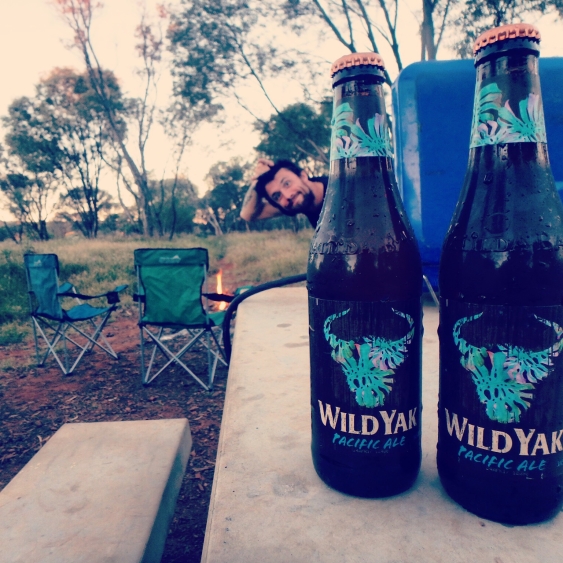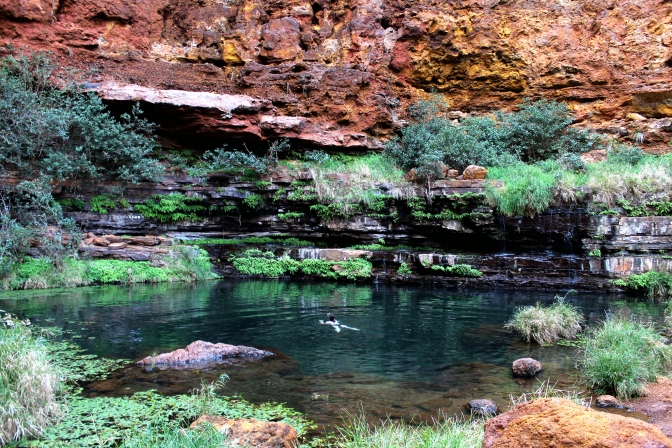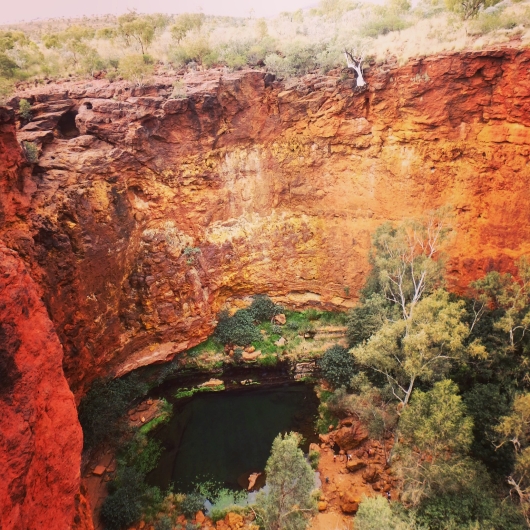If we could only pass on a single piece of advice to backpackers, grey nomads and any other type of traveller in Australia, it would be – visit Karijini National Park in central Western Australia. You just have to promise not to ruin it, because at the moment, compared to maxed out places like the Great Barrier Reef or Uluru, it’s a hidden travel treasure.
A peep into the Pilbara
To get there from WA’s west coast, we took the sealed road via Parabadoo and Tom Price. Both of these oddly named towns solely exist to support ore mining in the Pilbara, and as a result, they’re a bit on the dull side. Even the check out girl at the supermarket in Parabadoo was puzzled by our arrival, “What are you guys doing here?” she asked, “there’s nothing to see.” Actually there’s plenty to see if you’re into 4 wheel drives, mining infrastructure, red dirt or tumbleweed.

We noticed a seafood truck that had come all the way from the coast; as coast hangers for the last six weeks there was a certain sense of camaraderie so we picked up some Coffin Bay oysters and pink snapper from the travelling igloo (-50c inside) and continued on our way. The landscape leading to Karijini is full of breadcrumbs, bits of beauty in the form of craggy rocks and vibrant wildflowers, enticing you on through the red nothing of the outback.



It took us a few u-turns to find the right turn off to the park, the signage being quite understated. I guess this is to be expected from what is essentially a water park for discerning adults, no neon in sight.
Karijini is made up of small red mountains splintered by deep gorges formed over millions of years, when the mountain range rivalled Everest in height and majesty. The now tiny peaks are still #majesticas, with the juxtaposition of the gorges bringing the drama to ground level. This is perfect for us campervan kids because it means we can explore the cracks and crevices without forking out for a scenic flight. This expensive option becomes more necessary in other regions of WA such as the Kimberley or Bungle Bungles where you’re limited by your 2wd.
We spent the afternoon exploring Joffre Falls from above and below. Standing at the look out we heard a story about a French tourist who had climbed the waterfall and posed on the top rock platform for the ultimate selfie, only to fall to his death when the rocks gave way. You wouldn’t catch us messing about with anything called Joffre, you know you’re in for some evil when that guy’s around.




The sightseeing becomes less passive when you hit the ground. We were there in the very Dry (and Stinking Hot) so it was possible to reach Joffre Falls by climbing through the gorge. We learnt that gorge walking requires a mixture of hiking, rock climbing and wading, the more climbing and wading (or even swimming) you do to get to the end, the higher the ‘class’ of walk. The Joffre walk wasn’t particularly difficult but it sure was fun. It ended in a natural amphitheatre where the falls had created a pool. The pool was quite small at this time of year but it was enough to paddle in and the cold water and shade from the gorge walls gave us some much needed relief from the heat.
We stayed that night at the Aboriginal-owned eco retreat, which was set up for glamping as well as boring old camping, the main difference being safari tents and dawn yoga classes. We had no interest in forking out $20 for a lesson in bending, so engaged in some (free) night sky photography. There were no large cities or other forms of light pollution for miles around, so it made it possible to see and capture the haze of the milky way above. we traipsed around the spinifex with beer and tripod in hand trying to improve upon each shot.




We were really keen to get back into the gorges and got going quite early to avoid the heat, this time more prepared with hiking boots and a backpack with our reef shoes, water and swimwear. Hancock Gorge, a class 5 walk, was amazing. As you round each bend of the gorge you find another beautiful view, as the endless combinations of bright blue sky, red gorge, green trees and inky water rearrange like a kaleidoscope. We clambered up and down big boulders, crept along crevices, slipped through the tight squeeze of the Spider Walk where the gorge walls came together and waded through streams until we reached Kermit’s Pool, a deep, green swimming hole in a cavern of rippled red walls.





Each gorge had its own personality, some were short but steep, like the Handrail Pool walk, which you had to climb over fallen trees and boulders through a tunnel that fell away to again pool, necessitating a steep descent via the embedded railing. Other gorges were were longer, hosting a range of vegetation – starting with spinifex and wizened gums at the top with moss, twisted figs and vines closer to the bottom where the water ran. Circular Pool was incredible, as the rock face was covered in ferns and moss, which dripped down into the deep cold water. It was one of those places that still felt wild and magical, even though it was on the tourist circuit. After a lot of bullying Shelley finally got Gareth to swim in the pool with her, but he was out within a minute due to the fresh temperature.


At Oxers Lookout, where the Red, Weano, Joffre and Handcock gorges meet 130m below, we cooked up our Coffin Bay oysters on the camping stove using the recipe we’d come up with in Coffin Bay. Ignoring the bemused looks from passing grey nomads, who took two minutes to check the view and then retreated to their air-conditioned 4wds, we nommed our lunch looking over the gorge tops and termite nests.




Roadhouse blues
We left Karijini in a bit of a daze, drunk on the unique beauty of the place. This was put into stark relief when we arrived at the roadhouse for the night. It was a particularly heinous one, with the country bumpkin factor set at a slightly menacing 7, where 1 is ‘Oklahoma! ‘and 10 is ‘Deliverance’. It serviced the world’s biggest roadtrains (some over 60m) and was staffed by the world’s most depressed Irish backpackers, stuck in this dreadful nowheresville for three months to gain another year in sunny Australia. We struggled to sleep in the dirt pit they called a campground. At one point we looked out to see who had kept their truck running right outside our van for the last hour and realised it was the same seafood truck that had followed us from Exmouth.
The following morning, keen to leave, we made our way north to Port Hedland, one tiny van amongst the mammoth road trains, all aiming to drop their load at the huge ships that waited in Port Hedland. It looked like the industry was winding down in Port Hedland – stores were closed or abandoned, and residential sections of the area were quite derelict. We stopped at the water’s edge to watch the huge ships manoeuvre with the help of tug boats and pilot ships, before scarpering to Broome where we planned to camp for a few days. Driving out of Port Hedland, we saw the dazzling white mountains of Rio Tinto’s salt plant and pined for the dusky red ranges of Karijini.


Highs: The crystal clear waters flowing through Karijini Gorges
Lows: The yellow oily ooze flowing through our roadhouse sausage rolls



Dear both
I fell over your Instagram and fell in love with your pictures. Looks like the both of you are having an amazing adventure.
I am flying to Broome with a friend next week and we are planning on driving down to Karinjini National Park. Do you think we would be able to make it to Ningaloo Reef as well or will it be too ambitious? We only have 7 days unfortunately and we have to return the car in Broome 😦
Looking forward to hearing from you!
LikeLike
I think that it would be possible certainly. We left Exmouth a little late in the morning and drove to Karijini in time to make it to the eco-retreat with enough time to walk to the bottom of the waterfall nearby and shoot the impressive stars at night. If you left the moment the sun came up (something I think would be sensible to be doing on a week long trip anyway) and didn’t stop for lunch (sandwiches etc?), then you could do it faster. The real question is, how much of a 7 day trip do you want to spend driving? Exmouth to Broome was a day for us, and Broome to Karijini took us a little more than a day. Either way, we both hope you have an awesome time, let us know how the trip goes on here or on social media.
LikeLike
Thank you so much for your swift response. I think we will just have to do the driving as we definitely want to see the Ningaloo reef (which you probably agree is a must) and after reading your blog we really want to see the Karinjini National park. Do you have details on the camping spots you stayed at during your trip between the places at all? Also, if you’re still in Broome on Saturday we’d love to buy the two of you a beer!
Kind regards, Charlotte
Sent from my iPhone
LikeLike
In Broome we camped at Roebuck Caravan Park. This was the cheapest and while it didn’t have a pool you could paddle in the bay as it looked over Town Beach. We imagine it was a bit more relaxed than the ones in Cable Beach. We stayed at the Karijini Eco Retreat which was nice, but I believe there is another camp site on the Eastern side of the park, just be careful not to cross over to the Western side via the inland route if you don’t have a 4wd. Better to exit the park and use the western entrance. We stayed at the roadhouse just north of Karijini on our way to Port Hedland but wouldn’t recommend it. Better to stay another night in Karijini and then leave in the morning. We’ve left Broome now but thanks very much for the offer!
LikeLike